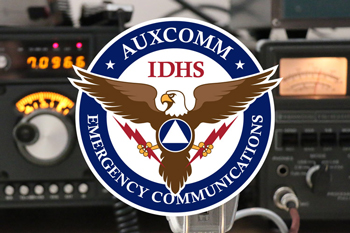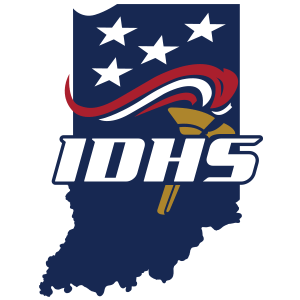AUXCOMM
Hours
8 a.m. – 4:30 p.m. Monday – Friday
except state-observed holidays
Indiana Dept. of Homeland Security
Indiana Government Center-South, Room E208
302 W. Washington St.
Indianapolis, IN 46204-2739
IDHS AUXCOMM policies/applications: mpattenaude@dhs.in.gov
IDHS AUXCOMM team lead: n9kvx@sbcglobal.net
IDHS AUXCOMM radio nets: jwonser@gmail.com
About Amateur Radio and AUXCOMM


U.S. amateur radio operators are volunteers, licensed by the Federal Communications Commission (FCC), who communicate through allocated radio frequencies. In Indiana, there are more than 16,000 amateur operators with active licenses. Many amateur radio operators, often called hams, assist public safety agencies using their skills and personal radio equipment to back up or supplement communications. Radio Amateur Civil Emergency Service (RACES) is a status granted to licensed hams who are also certified volunteers registered with an emergency management agency.
The Indiana Department of Homeland Security (IDHS) has sites that support a RACES team (now called the IDHS AUXCOMM team) with radio equipment used during activations, and the IDHS communications director is responsible for the maintenance and training of this pool of volunteers. The team is called upon during emergencies or with reasonable expectation of potential emergencies requiring IDHS State Emergency Operations Center (SEOC) support. The AUXCOMM team members support the SEOC not only with communications via amateur radio, but also with any legal form of communications on which they are trained and qualified. For example, they might use Public Safety Land/Mobile Radio (LMR), satellite radio/phone/data or Broadband Global Area Network (BGAN) terminals.
Registering as Volunteer or Joining IDHS AUXCOMM
Amateur radio operators in Indiana who want to be added to the IDHS list of volunteers who may be available across the state during emergency operations may register by completing the AUXCOMM Interest Form using the link below. Additionally, operators who would like to join the IDHS AUXCOMM team may use the same form to indicate their interest and answer additional questions to apply for the team.
Note: A background check will be required for those applying to join the AUXCOMM team, but it is not required for registering as an operator.
Activation Levels
There are four levels of activation for the IDHS AUXCOMM team. The levels are not linked to the SEOC activation levels.
| Activation Level | Description |
|---|---|
| Level IV – Standby | Members are notified of the potential for activation and are expected to maintain awareness of the situation via WebEOC. |
| Level III – Home Operation | Members are activated, but are not to report to the SEOC. Possible situations are:
|
| Level II – Activation | Members are requested to staff the station(s) located in the SEOC, logistics facility or at home, as directed, full-time or part-time. |
| Level I – Deployment | Members are requested to assist with communications at locations other than their home stations or the SEOC. Deployment requires activation of a mobile support unit listing the names of the AUXCOMM team members deployed (see Annex for required/recommended equipment during deployments). |
- Level IV – Standby: Members are notified of the potential for activation and are expected to maintain awareness of the situation via WebEOC.
- Level III – Home Operation: Members are activated, but are not to report to the SEOC. Possible situations are:
- To provide “situational awareness” during severe weather or other events
- To provide maximum communications capability with other amateurs
- To provide communications when working from the SEOC may not be possible, or desired (e.g., pandemic, damage to the SEOC or relocation of the SEOC)
- Level II – Activation: Members are requested to staff the station(s) located in the SEOC, logistics facility or at home, as directed, full-time or part-time.
- Level I – Deployment: Members are requested to assist with communications at locations other than their home stations or the SEOC. Deployment requires activation of a mobile support unit listing the names of the RACES team members deployed (see Annex for required/recommended equipment during deployments).
Activation Authority
Levels IV, III and II may be done by the IDHS communications director, SEOC manager or response director. Level I requires activation of a mobile support unit, which may be authorized by the governor or the IDHS executive director, by request (Indiana Code 10-14-3-19).
Frequencies
After activation, the IDHS AUXCOMM team will monitor 3.920 MHz LSB and 7.290 MHz LSB. Both frequencies are +/- QRM. Depending on the nature of the emergency, the following frequencies and systems may be monitored as well:
| Minutes (after the hour) | Frequency | Mode |
|---|---|---|
| 0-10 | 3.920 MHz (Day), 7.290 MHz (Night) | LSB |
| 11-20 | 147.210 MHz (in future will be DMR) | FM |
| 21-30 | W9FBZ | FM |
| 31-40 | 3.920 MHz (Day), 7.290 MHz (Night) | SSB |
| 41-50 | 147.210 MHz | FM |
| 51-59 | 60m | Channel 4 |
| Note: W9FBZ 147.210 (MHz) +600 offset 88.5 (tone) linked to 224.800 MHz and Echolink | Echolink | 690934 |
WinLink
Winlink email messages can be sent to:
- HF: W9SEM@winlink.org
- VHF: Pending
